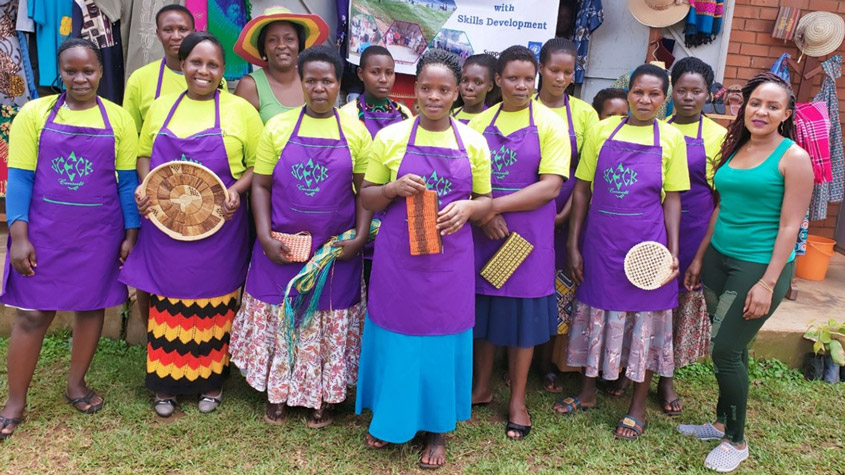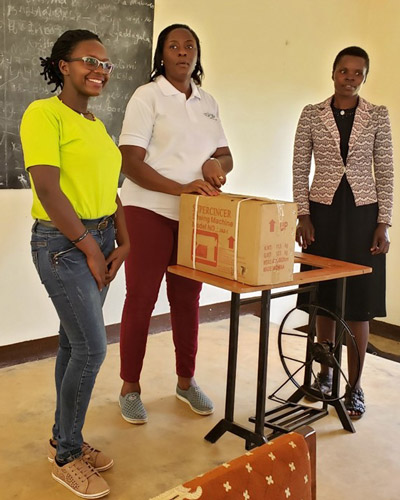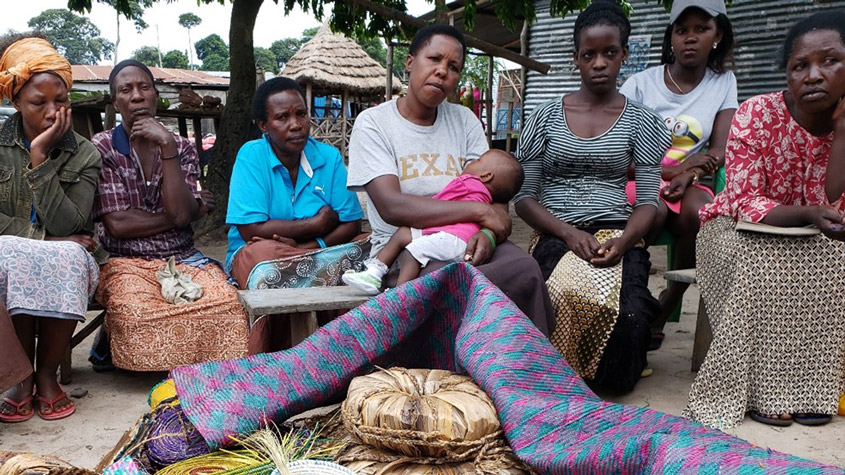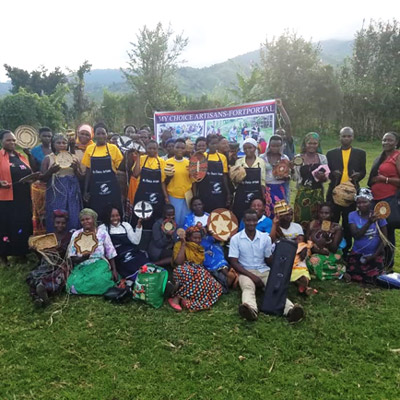
Tourism Inclusion for All - Fostering Social Entrepreneurship in Uganda
By Anna Sinkevich, Traditional Knowledge Division, WIPO
Charlotte Kazoora, a social entrepreneur from Uganda is working to improve the livelihoods of local communities through practical skills trainings, including branding. In a recent interview with WIPO Magazine, Kazoora explains how her social enterprise, Tourism Inclusion for All (TIFA), is creating new livelihood opportunities for local communities across Uganda. She also talks about the challenges artisans face in the region and how IP is woven into the fabric of her business consultancy.
IP tools can protect the interests of communities and can add value to the products they create.

How did you start working with vulnerable communities?
At first, I saw that these communities needed support and just started working with them, using my own financial resources. Then in 2016, I came across an advert from the United Nations Development Program (UNDP) for someone to improve the livelihoods of local communities in tourist areas. I wrote a project proposal and managed to secure a USD 40,000 grant. That allowed me to set up four groups: a youth group specializing in handicrafts made from cattle horn, and three groups of women basket makers.
While rolling out that project, I realized that so many other communities needed similar support. So, I applied for another grant, and have been working in this field ever since.

to members of the Kalangala community at Bugala Island as part
of the Kazoora’s UNDP-grant project. (Photo: Kyokusiima Estella)
How are you supporting the livelihoods of people in local communities?
My social enterprise called TIFA offers women and young people practical skills training across the tourism value chain. We work in popular tourist spots in Uganda, such as the Rwenzori Mountains, Kalangala Island on Lake Victoria, and the river Nile and surrounding lakes in Eastern Uganda.
I am also the founder and CEO of the SCECK Consultant, a company that markets and sells products created by the women and young people who take part in TIFA’s training programs. I am an accountant by training and am very keen to ensure that our projects have a serious business focus.
Tell us about the communities you are working with?
I mainly work with local communities in western and central Uganda. Who I work with really depends on the opportunities that exist in each tourist spot. It is always good to implement a project in a tourism hot spot because these locations offer good market access.
I usually reach out to communities through local government authorities, as this is a good way to win the trust of the communities. Local government authorities can also help to mobilise local people and identify the best families to work with.
What challenges do the women and young people face in these communities?
For women, the main challenges are poverty, domestic violence, and financial inequality. These emerge from local norms, such as a belief that women are not supposed to work. We are trying to change this narrative by showing that women can earn money. When they do, their households are better off.
One of the big challenges we face is that most girls have either never gone to school or dropped out of school at primary level.
One of the big challenges we face is that most girls have either never gone to school or dropped out of school at primary level. This excludes them from applying for higher paid jobs that require qualifications. The same also applies to many boys. I work with girls and boys, especially school dropouts.
In practical terms, how do you go about helping these communities?
Communities living in these tourist areas are extremely poor, but they are sitting on a gold mine. Many local and international tourists visit these areas, so there is huge potential for local communities to develop tourism-related businesses. The problem is the local communities don’t know how to tap into that potential. That’s why we came up with a training program that focuses on both skills and business development. I'm currently supporting more than 300 women in this way.
Communities living in […] tourist areas are extremely poor, but they are sitting on a gold mine.
To be able to reach out to and empower more communities, I decided to join the Uganda Women Entrepreneurs Association. With more than 2,000 members, it is one of the biggest women entrepreneurs’ groups in Uganda. Becoming a member of the Association is opening up new opportunities to roll out our empowerment programs for women and youth. I also keep a regular look out for available grant programs that will enable us to support more communities.
And what do TIFA’s training programs involve?
Our TIFA programs have three main components. First, with the help of local government, we identify and mobilize trainees. Second, we teach trainees practical handicraft skills - these typically depend on the community and their location. And third, we teach the trainees basic business skills, such as marketing and sales, branding, book-keeping, and records management. Through these programs, we show our trainees where and how to sell their handicrafts. This is a crucial step in enabling them to escape poverty.
We teach the trainees basic business skills, such as marketing and sales, branding, book-keeping, and records management.
What kind of handicrafts do the local communities produce?
Western Uganda is home to Ankole Longhorn cattle, one of the oldest Indigenous cattle breeds in Uganda. For that reason, cattle horn is one of the main materials we use in this area. Artisans are still using rudimentary methods to produce cow horn crafts. They use machines to cut the horns and then craft them manually. We don’t yet have processing plants to transform cattle horn into well-crafted and polished final products.
In central Uganda, the artisans typically focus on basketry, tailoring and knitting. They use locally available organic materials, such as banana fibre and raffia.
In central Uganda, the artisans typically focus on basketry, tailoring and knitting. They use locally available organic materials, such as banana fibre and raffia. We make a point of encouraging the communities to work with local materials. That way, they can sustain their work. Ideally, they can produce a minimum number of products without any external financial support.

What do you most like about your work?
This work is so rewarding. You can see the direct impact it is having on these communities. That’s why I enjoy it so much.
Are there any success stories that stand out?
Yes, there are many, but a couple stand out. First, about five years ago, I started working with around 20 women in Kalangala who were taking part in our “Family at Work Model” program. At the time, these women were focused entirely on supporting their husbands and maintaining their households. For the most part, their children had dropped out of school.
We trained them to make and sell baskets. Two years on, these women have their own registered, tax-paying businesses, and more importantly, all their children are now back in school. That was a direct result of the skills they acquired from participating in our program. They are now sharing those skills with family members. The community is beginning to thrive.
And second, I remember a young girl called Juliet from a community in Kalangala. She had dropped out of school, lost confidence in herself and felt her world had come to an end.
At first, she had no interest in basketry. Her passion was for motorcycles, but she didn’t have a driving license and couldn’t afford a motorbike. Still, she went through the skills training, and on the strength of that has been able to fulfil her dream. She is now the proud owner of a motorbike. There are so many other wonderful stories of women who have improved their lives and fulfilled their dreams through basketry.
What is the importance of traditional knowledge and culture to these communities?
When it comes to basket making, the women we work with weave in a way that depicts their local environment. By looking at a basket, I can identify which part of the country it comes from. For example, the traditional baskets of the Ankole sub-region of western Uganda reflect the mountains; the women weave them in the form of a cone. Whereas in central Uganda, women use a different technique. Here the weavers depict Lake Victoria, so the baskets are more fluid in their form, style and look, and are round.
Cultural sensitivity can make all the difference to the successful implementation of a project.
When working with communities in Uganda, it is crucial to be familiar with their cultural norms and the “dos” and “don'ts.” Such cultural sensitivity can make all the difference to the successful implementation of a project. Before going to a community, I spend a lot of time understanding these cultural aspects.

quality control and product standardization. This group makes hand-made
organic baskets for decorative and traditional use.
(Photo: Kyokusiima Estella)
How did you learn about intellectual property?
I first learned about intellectual property (IP) around two years ago, through the Uganda Women Entrepreneurs Association. At first, I thought IP was something that only benefitted big corporations. I never considered it was relevant to me or to artisans I work with. But when I went through WIPO’s Training, Mentoring and Matchmaking Program on IP for Women Entrepreneurs from Indigenous Peoples and Local Communities, I learned that IP tools can protect the interests of communities and can add value to the products they create.
At first, I thought IP was something that only benefitted big corporations. I never considered it was relevant to me or to artisans I work with.
Are the artisans’ products sold under a brand or do they sell them individually?
We’re currently in the process of securing trademark rights in the brand name Kantu, and its logo. Kantu means something little and beautiful in a local language. Trademark registration is our top priority and has been made possible thanks to support from WIPO. Through the WIPO training course, we have been able to secure the services of a local attorney to help with the registration formalities. Until that process wraps up, we will continue to sell our handicrafts online under the banner of SCECK Crafts.
What is the story behind the Kantu logo?
The logo depicts a drumming woman. Traditionally, our way of calling people together is through drumming. As our aim is to empower as many women as possible, and as we are calling people together to improve their livelihoods, we felt drumming was a fitting symbol.
How are you marketing your brand?
We have sales contracts with various local hotels, including the gift shops of ecotourism lodges, which are basically hotels built in national parks or wealthier areas. These hotels attract many international tourists and represent our main market.
Trademark registration is our top priority.
Also, every month we hold an open-air market where our artisans can sell their products directly to customers. We also have corporate customers, but their needs tend to be seasonal.
We recently established an online shop, and that has opened up many new opportunities. It was a lifesaver during COVID-19, which hit the tourism sector very hard. The pandemic was a real turning point for us. That was when we realized we had to move into e-commerce. But the main challenge with online marketing is keeping up the pace, and posting enough to make sure people keep returning to our site. I need a full-time social media and website manager these days.
How would you like to see your TIFA evolve?
So many people think that if you didn’t go to school, you have no brains. That’s simply not true. Many of the people I work with haven’t been to school, but they can learn anything. If you sit with them, talk to them, and teach them, they come up with amazing ideas and products. They simply need an opportunity to express themselves, and to learn how to implement their ideas. They just need support and skills to help them on their way.
In future, I see myself establishing a skills training centre where local communities come to learn new skills and develop their products, which we would then sell on to our clients. This would be a great way for everyone to learn about and enjoy the culture of these communities.
Indigenous Peoples and Local Communities Women Entrepreneurship Program
The WIPO Training, Mentoring and Matchmaking Program on Intellectual Property for Women Entrepreneurs from Indigenous Peoples and Local Communities (WEP) aims to encourage women entrepreneurship, innovation and creativity related to traditional knowledge and traditional cultural expressions. It seeks to equip these women entrepreneurs with the knowledge and skills to make strategic and effective use of intellectual property rights in support of their communities’ entrepreneurial activities.
Since its launch in 2019, the WEP has supported over 100 women entrepreneurs from Indigenous and local communities from 63 countries. The 2023 - 2024 program is currently underway.
The WIPO Magazine is intended to help broaden public understanding of intellectual property and of WIPO’s work, and is not an official document of WIPO. The designations employed and the presentation of material throughout this publication do not imply the expression of any opinion whatsoever on the part of WIPO concerning the legal status of any country, territory or area or of its authorities, or concerning the delimitation of its frontiers or boundaries. This publication is not intended to reflect the views of the Member States or the WIPO Secretariat. The mention of specific companies or products of manufacturers does not imply that they are endorsed or recommended by WIPO in preference to others of a similar nature that are not mentioned.